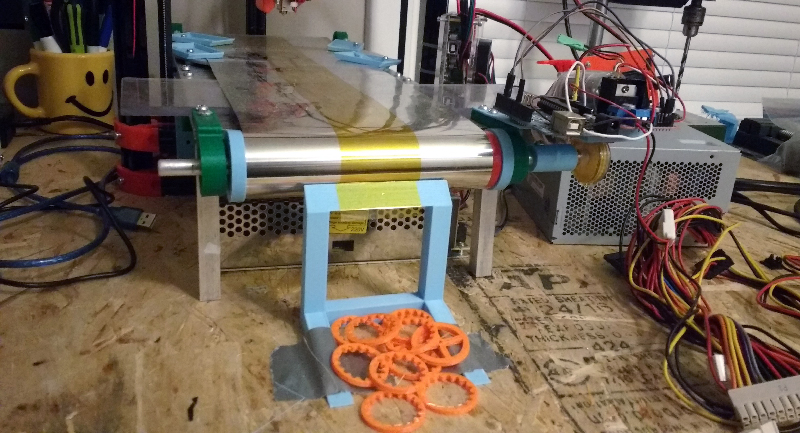3D printers can be used in a manufacturing context. This might be surprising for anyone who has waited hours for their low-poly Pokemon print, but for low-volume plastic parts, you can actually run a manufacturing line off a few 3D printers. The problem with 3D printers is peeling the print off when it’s finished. If only there were a conveyor belt solution for a bed that wasn’t forgotten by MakerBot.
[Swaleh] may have a solution to the problem of un-automated 3D printers. He’s designing the WorkHorse 3D, a printer that uses a conveyor belt as a bed. When the print is finished, the conveyor belt rolls forward, depositing a printed part in a bin. It’s the solution to truly automated printing.
The use of conveyor belts to automate a batch of 3D prints isn’t a new idea. Way back in the Before Time, MakerBot released the Automated Build Platform, and used it in production to print off parts for Thing-O-Matics. This bit of Open Hardware was left by the wayside for some reason, and last year saw the invention of a new type of conveyor belt-based printer, The Infinite Build Volume Printer (for lack of a better name) from [Bill Steele]. This printer angles the print bed at 45 degrees, theoretically allowing for prints that are infinitely long. This idea was turned into the Printrbot Printrbelt, and the Blackbelt 3D printer was made public around the same time.
[Swaleh]’s printer is not of the infinite build volume variety. Instead of concentrating on creating long beams, most of the engineering work has gone into making a printer that’s designed to just push prints out. The conveyor belt bed is flat — and may unfortunately infringe on the MakerBot patents — but if you want a printer that’s designed to dump parts out like a very slow injection molding machine, this is the design you want.
The print queue application for this project is just a simple desktop app that serves as a buffer for G-code files. The app sends one G-code file off to the printer, rolls the bed forward, and queues up the next part. It’s simple, yes, but there aren’t too many things that do this now because there aren’t too many printers built to be factories. It’s impressive, and you can check out a few videos of this printer in action below.




















Why is it that when I was making something like this in 2013, nobody cared? I submitted it on HaD and everything.
https://youtu.be/TRJRJJxBUIo
https://youtu.be/xef6TdkXVxY
Documentation. You’ve got two grainy videos totally about 6 minutes. This guy has posted files, clear video, and a written explanation. It’s tough to write a short blub about something like this; it’s much easier to write about [Swaleh]’s project.
> This bit of Open Hardware was left by the wayside for some reason
Well, it *was* open, and then MakerBot patented it. In the “thanks for all your IP, open hardware community! This is ours now, and you can talk to our lawyers” way.
ohhh wait, that was irony.
Hopefully resoundingly answered in a “prior art” way.
I think their response was more of a “screw you, it’s now first to file in the US” kind of way.
Nobody’s ponied up to retain a legal team to actually fight the thing. Stratasys has plenty of money for that.
Makerbot can suck it. They’re just the people who run Thingiverse, and there are much better alternatives for it. Hope they crash and burn.
NVBots has made a pretty decent (closed source) solution. Basically it’s a knife-like print separator that swipes the print off the base when done. It seems to work decently well.
nvbots.com
There’s a benefit to the belt driven solutions over the “push it off the bed” solutions mentioned above. Belt-driven platforms can remove prints with large, flat bottoms (large contact surface area) without having to separate it all at once like you would on a solid flat bed. Those can be difficult to remove unless you print on a raft or something (like shown in comment above) which can affect the smoothness of the bottom surface.
https://www.youtube.com/watch?v=Viy928RLsdU
A problem with a belt is it won’t be able to hold flat against a print that wants to warp. It’ll just curl the belt up.
Have the conveyor belt on a vacuum table? Would need to use very very fine pitch holes as to not warp the medium (foil?)
great printing with canon.
Although well outside the realm of your consumer nor open source (boo!), 3D Systems has the modular Figure 4 DLP printer which is a fully automated production system. Post processing and all. Automated systems move the completed part over into a processing chamber post build for cleaning, drying, and curing.
Next project. Miniature factory.
What a stunning printing! MarketBot can be a solution.